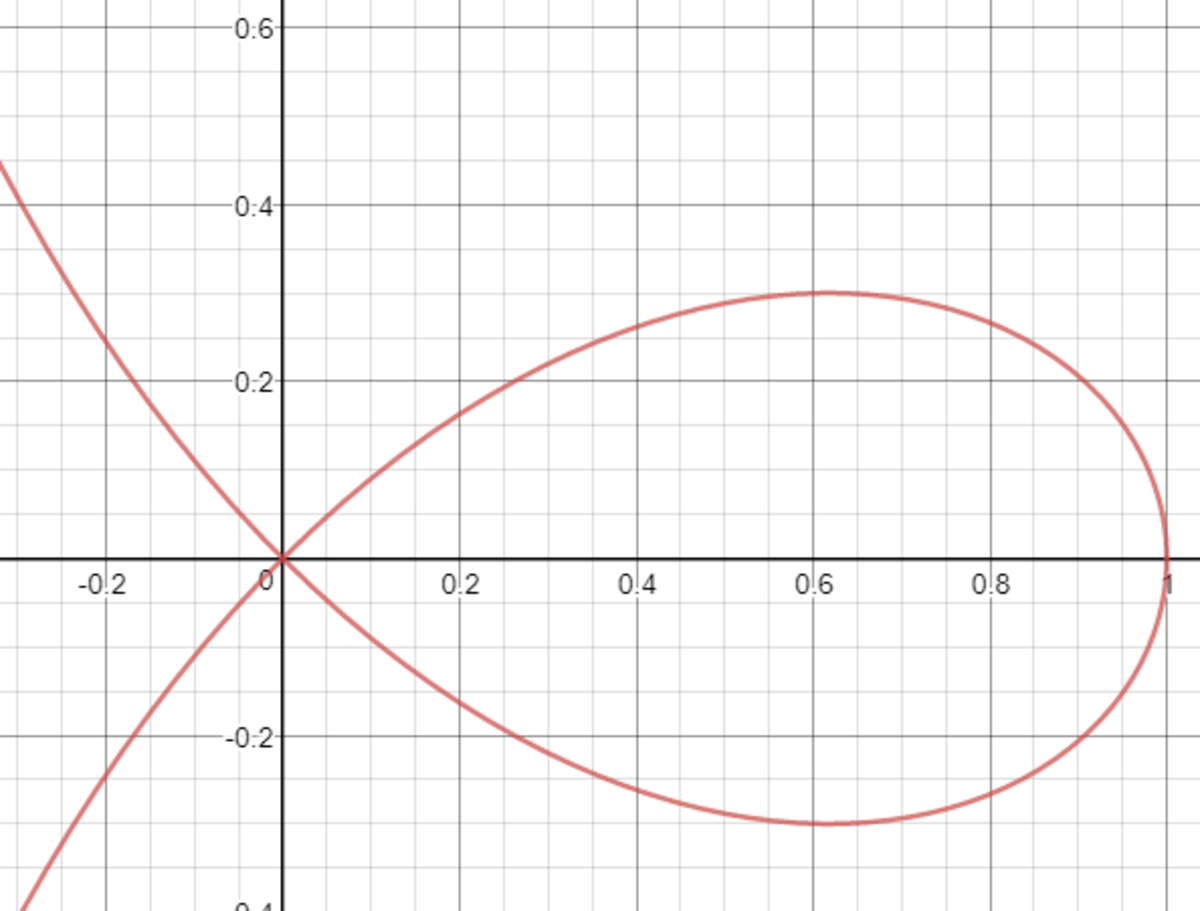Integration #7 (Corrected)
x ( x − y 2 ) = x 3 + y 2
Find the area bounded by above curve to three decimal places.
The answer is 0.4292037.
This section requires Javascript.
You are seeing this because something didn't load right. We suggest you, (a) try
refreshing the page, (b) enabling javascript if it is disabled on your browser and,
finally, (c)
loading the
non-javascript version of this page
. We're sorry about the hassle.
2 solutions
Rewrite the equation to isolate each variable:
x ( x − y 2 ) x 2 − x y 2 x 2 − x 3 x 2 ( 1 − x ) y 2 = x 3 + y 2 = x 3 + y 2 = y 2 + x y 2 = y 2 ( 1 + x ) = 1 + x x 2 ( 1 − x ) .
If we graph this function, we see that it encloses a loop in the interval x ∈ [ 0 , 1 ] . Since the function is symmetric over the x-axis, we can find the area of the top portion of this loop then multiply by two. The top portion is bounded by the x-axis and the graph of
y = 1 + x x 2 ( 1 − x ) = 1 − x 2 x ( 1 − x ) ,
so we must find ∫ 0 1 1 − x 2 x ( 1 − x ) d x . Make the substitution θ = arcsin x . Then, we have x = sin θ and d θ = 1 − x 2 d x . When x = 0 , θ = 0 , and when x = 1 , θ = 2 π . All these substitutions yields
∫ 0 1 1 − x 2 x ( 1 − x ) d x = ∫ 0 2 π ( sin θ ) ( 1 − sin θ ) d θ = ∫ 0 2 π ( sin θ − sin 2 θ ) d θ = ∫ 0 2 π ( sin θ − 2 1 − cos 2 θ ) d θ = ∫ 0 2 π ( sin θ + 2 1 cos 2 θ − 2 1 ) d θ = [ − cos θ + 4 1 sin 2 θ − 2 1 θ ] 0 2 π = ( 0 + 0 − 4 π ) − ( − 1 + 0 − 0 ) = 1 − 4 π .
The total area is twice this value, which is 2 − 2 π ≈ 0 . 4 2 9 .
Rewrite the expression as x 2 − y 2 = x 3 + x y 2 . Then do the substitution (polar coordinates) x = r cos θ , y = r sin θ . This turns the expression into r 2 ( cos 2 θ − sin 2 θ ) = r 3 ( cos 3 θ + cos θ sin 2 θ ) ⟹ cos 2 θ − sin 2 θ = r cos θ ( cos 2 θ + sin 2 θ ) ⟹ r cos θ = cos 2 θ − sin 2 θ ⟹ r = cos θ − sin θ tan θ . Here is a graph of the shape of the function:
The closed curve is bounded by the values the function takes in two successive values of θ such that r = 0 so let's solve for that: cos θ − sin θ tan θ = 0 ⟹ sin θ tan θ = cos θ ⟹ tan 2 θ = 1 ⟹ θ = 2 π n − 4 π . Plugging in n = 0 , 1 we get the bounds − 4 π ≤ θ ≤ 4 π . With this we can describe the area via by following double integral:
∫ − 4 π 4 π ∫ 0 cos θ − sin θ tan θ r d r d θ = 2 1 ∫ − 4 π 4 π ( cos θ − sin θ tan θ ) 2 d θ = 2 1 ∫ − 4 π 4 π cos 2 θ − 2 cos θ sin θ tan θ + sin 2 θ tan 2 θ d θ = 2 1 ∫ − 4 π 4 π cos 2 θ − 2 cos θ sin θ cos θ sin θ + ( 1 − c o s 2 θ ) cos 2 θ sin 2 θ d θ = 2 1 ∫ − 4 π 4 π cos 2 θ − 2 sin 2 θ + tan 2 θ − sin 2 θ d θ = 2 1 ∫ − 4 π 4 π cos 2 θ + tan 2 θ − 3 sin 2 θ d θ
This is now a sum of standard trigonometric integrals and it is equal to 2 1 ( 4 − π ) = 2 − 2 π .